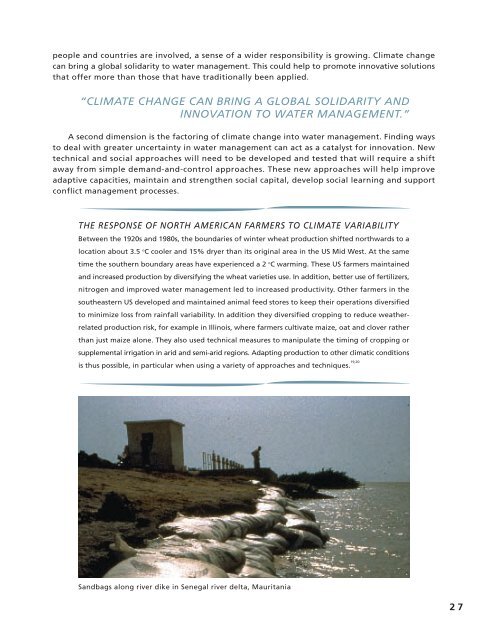Adaptation of water resources management to climate change
Adaptation of water resources management to climate change
Adaptation of water resources management to climate change
You also want an ePaper? Increase the reach of your titles
YUMPU automatically turns print PDFs into web optimized ePapers that Google loves.
people and countries are involved, a sense <strong>of</strong> a wider responsibility is growing. Climate <strong>change</strong>can bring a global solidarity <strong>to</strong> <strong>water</strong> <strong>management</strong>. This could help <strong>to</strong> promote innovative solutionsthat <strong>of</strong>fer more than those that have traditionally been applied.“CLIMATE CHANGE CAN BRING A GLOBAL SOLIDARITY ANDINNOVATION TO WATER MANAGEMENT.”A second dimension is the fac<strong>to</strong>ring <strong>of</strong> <strong>climate</strong> <strong>change</strong> in<strong>to</strong> <strong>water</strong> <strong>management</strong>. Finding ways<strong>to</strong> deal with greater uncertainty in <strong>water</strong> <strong>management</strong> can act as a catalyst for innovation. Newtechnical and social approaches will need <strong>to</strong> be developed and tested that will require a shiftaway from simple demand-and-control approaches. These new approaches will help improveadaptive capacities, maintain and strengthen social capital, develop social learning and supportconflict <strong>management</strong> processes.THE RESPONSE OF NORTH AMERICAN FARMERS TO CLIMATE VARIABILITYBetween the 1920s and 1980s, the boundaries <strong>of</strong> winter wheat production shifted northwards <strong>to</strong> alocation about 3.5 o C cooler and 15% dryer than its original area in the US Mid West. At the sametime the southern boundary areas have experienced a 2 o C warming. These US farmers maintainedand increased production by diversifying the wheat varieties use. In addition, better use <strong>of</strong> fertilizers,nitrogen and improved <strong>water</strong> <strong>management</strong> led <strong>to</strong> increased productivity. Other farmers in thesoutheastern US developed and maintained animal feed s<strong>to</strong>res <strong>to</strong> keep their operations diversified<strong>to</strong> minimize loss from rainfall variability. In addition they diversified cropping <strong>to</strong> reduce weatherrelatedproduction risk, for example in Illinois, where farmers cultivate maize, oat and clover ratherthan just maize alone. They also used technical measures <strong>to</strong> manipulate the timing <strong>of</strong> cropping orsupplemental irrigation in arid and semi-arid regions. Adapting production <strong>to</strong> other climatic conditionsis thus possible, in particular when using a variety <strong>of</strong> approaches and techniques. 19,20Sandbags along river dike in Senegal river delta, Mauritania27











![View full document [PDF 988.55 KB] - PreventionWeb](https://img.yumpu.com/47733942/1/184x260/view-full-document-pdf-98855-kb-preventionweb.jpg?quality=85)
![View full document (in French) [PDF 4.96 MB] - PreventionWeb](https://img.yumpu.com/47223870/1/184x260/view-full-document-in-french-pdf-496-mb-preventionweb.jpg?quality=85)


![View full document [PDF 25.02 MB] - PreventionWeb](https://img.yumpu.com/44204570/1/190x234/view-full-document-pdf-2502-mb-preventionweb.jpg?quality=85)
